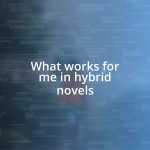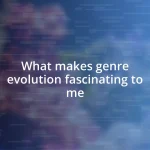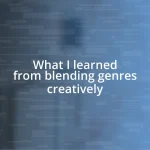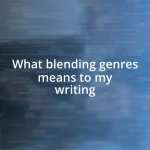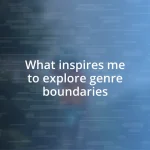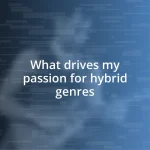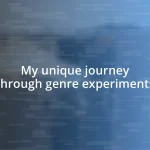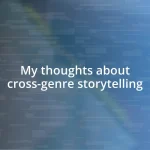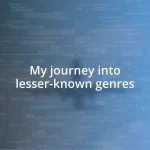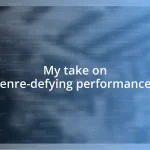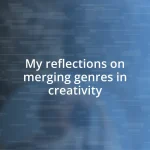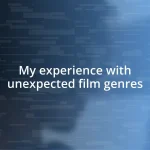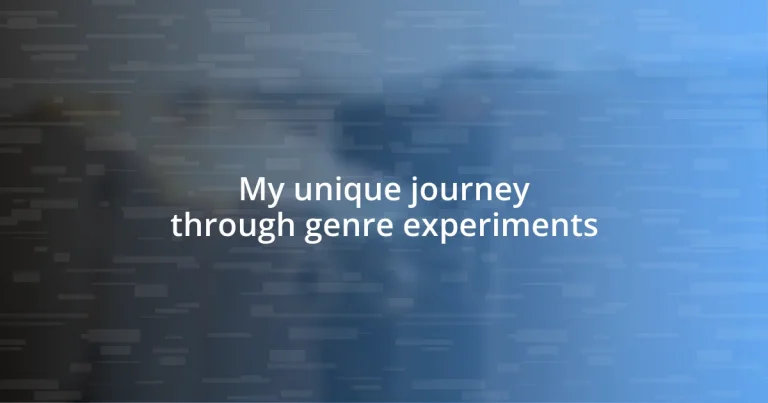Key takeaways:
- The journey into genre exploration sparked a curiosity to experiment with diverse genres, enhancing narrative appreciation and storytelling depth.
- Genre blending reveals emotional complexities and fosters personal growth, as stepping out of comfort zones can lead to significant creative breakthroughs.
- Documenting the creative process helps track progress, explore emotional influences, and channel inspiration effectively into writing.
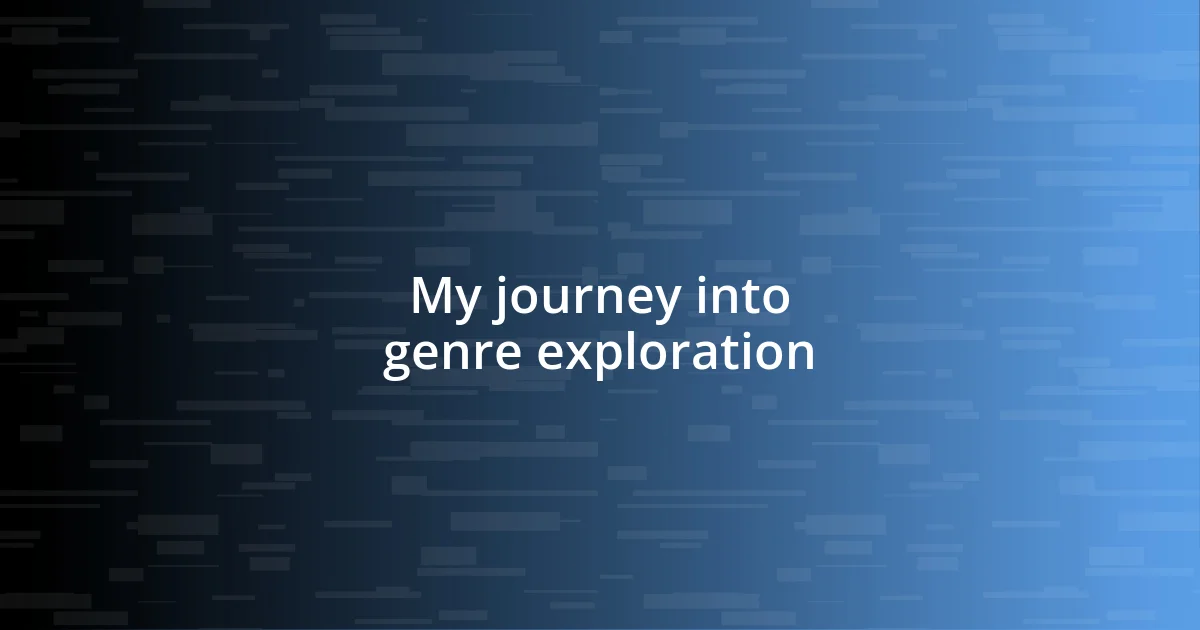
My journey into genre exploration
My journey into genre exploration began unexpectedly when I picked up a fantasy novel at age twelve. I vividly remember losing myself for hours in a world filled with magic and wonder. How could words on a page transport me to such fascinating realms? It sparked a curiosity in me to delve into genres beyond my comfort zone.
I often found myself experimenting with mystery and thrillers in my teenage years, discovering the thrill of untangling plots. I recall the rush I felt while deciphering clues, almost like I was a detective myself. Wasn’t it exhilarating to put together pieces of the puzzle? This genre opened my eyes to the intricacies of narrative structure and the power of suspense, shaping my appreciation for storytelling.
As I transitioned into adulthood, genres like historical fiction and science fiction began beckoning me with their depth and imagination. I remember being moved by characters whose lives wove through real events I’d never encountered. It made me wonder, how can fiction reflect reality so powerfully? This blend of genres made me realize that exploring diverse storytelling methods could not only entertain but also enrich my understanding of the human experience.
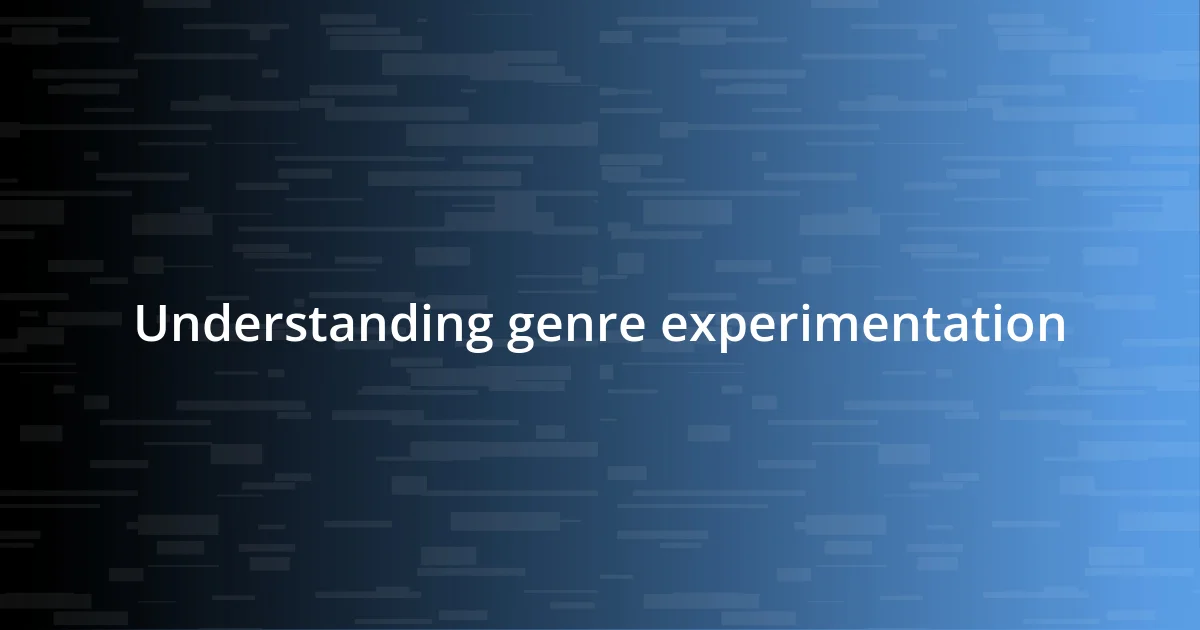
Understanding genre experimentation
Understanding genre experimentation requires an open mind and a willingness to step outside conventional boundaries. I remember the first time I tried my hand at combining romance with science fiction. It was an exhilarating risk, as I navigated the emotional depths of love within an imaginative future. How could I merge these two worlds? The process felt like crafting a mosaic – each piece uniquely contributing to a vivid overall picture of human connection.
As I explored different genres, I often discovered unexpected lessons about life and creativity. One memorable experience was writing a piece that blended horror with comedy. I learned that juxtaposing fear and laughter could create an unexpected tension, enriching the narrative’s emotional landscape. It’s fascinating how experimenting with these genres revealed new facets of my writing style and understanding of storytelling. Isn’t it incredible how stepping out of our comfort zones can unfold new dimensions of creativity?
Through my journey, I’ve come to appreciate genre experimentation not just as a creative tool, but as a way to connect with readers on deeper levels. Engaging with diverse genres enabled me to evoke a range of emotions—from joy and excitement to dread and curiosity. Each experiment left me with a greater appreciation for storytelling’s versatility and its power to resonate with our shared experiences.
| Aspect | Details |
|---|---|
| Definition | Exploration beyond traditional genre boundaries. |
| Purpose | To enrich storytelling through diverse emotional and narrative techniques. |
| Personal Impact | Fosters growth as a writer, encouraging creativity and connection with readers. |
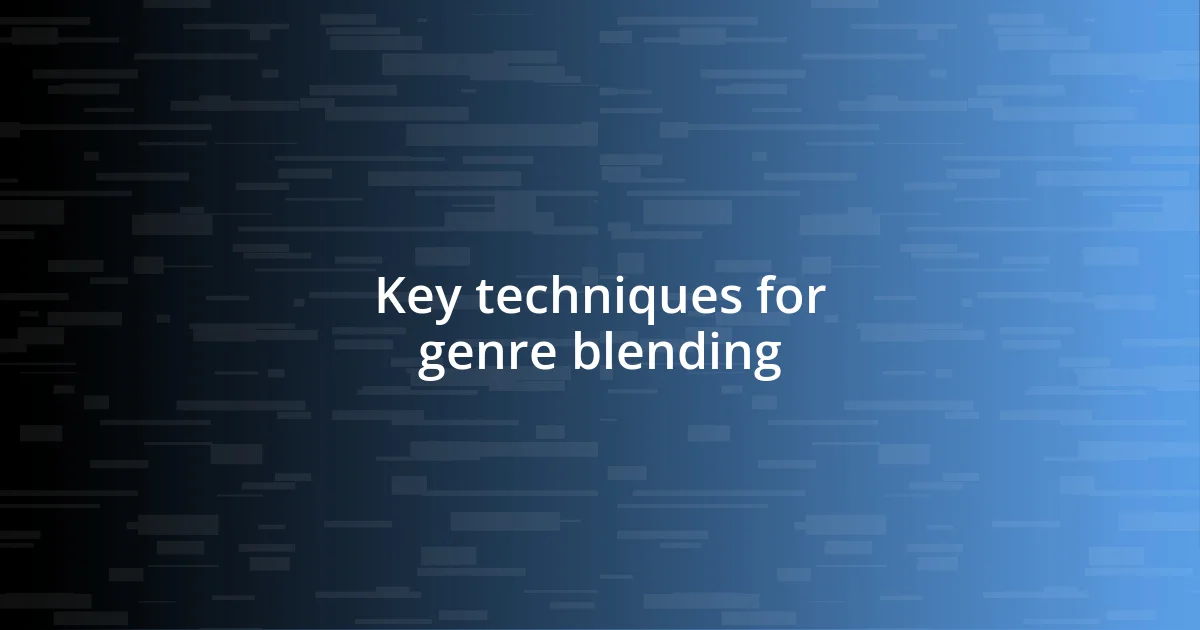
Key techniques for genre blending
Genre blending is a thrilling endeavor that really challenges the boundaries of traditional storytelling. One of the techniques I find essential is understanding the core elements of each genre involved. When I wrote a story merging fantasy with mystery, I focused on the magical system while layering intriguing puzzles for the characters to solve. This approach not only maintained a sense of wonder but also kept readers guessing. It’s like juggling—each element needs attention to create a balanced narrative that feels seamless.
Here are some key techniques I believe can enhance your genre blending:
- Establish Clear Character Motivations: Ensure your characters have believable reasons that align with both genres, drawing readers in emotionally.
- Mix Tone and Style Wisely: Maintain a consistent voice that respects both genres while finding harmony between serious and light-hearted moments.
- Choose a Central Theme: A common theme can bridge disparate genres effectively, allowing for a deeper exploration of ideas—like love or loss amidst fantastical elements.
- Craft Engaging World-Building: Blend settings that highlight unique aspects from each genre; this creates a rich backdrop for your story’s conflicts.
- Experiment with Structure: Feel free to play with non-linear storytelling or alternating perspectives to reflect the duality of the genres.
I’ve also learned the importance of pacing; marrying the suspense of a thriller with the expansive world-building of fantasy can create a uniquely compelling rhythm. I remember writing a piece that took place during an epic battle, where the stakes were high and tension thick in the air. The urgency of the thriller elements pushed the plot forward while the fantasy backdrop enriched the overall experience. This blend turned into one of my favorite projects, because it not only challenged my skills but also taught me how to amplify emotions through careful genre integration.
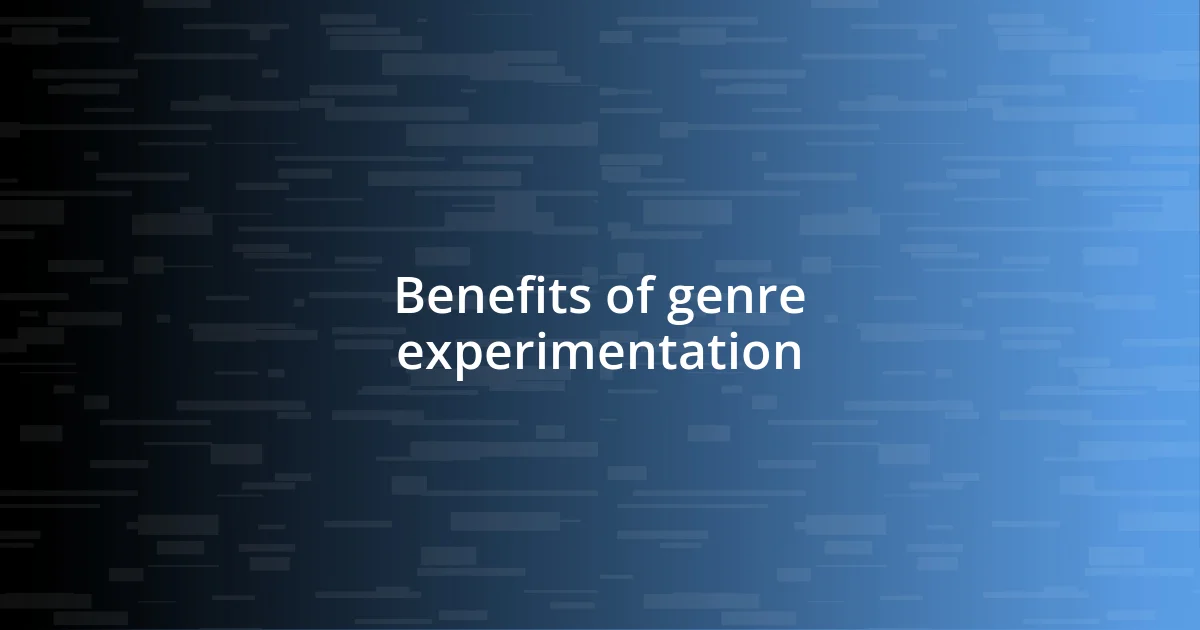
Benefits of genre experimentation
Genre experimentation offers a wealth of benefits that can drastically enhance a writer’s craft. One of the most striking advantages I’ve encountered is the expansion of my creative toolkit. The minute I dabbled in mixing genres, it felt like unlocking a treasure chest filled with fresh ideas and perspectives. For instance, when I combined elements of magical realism with a contemporary setting, I not only surprised myself but also sparked a curiosity within my readers. Have you ever realized how genre blending can evoke a sense of wonder that single genres sometimes miss? It’s a rewarding experience to see your audience connect with the story on different levels.
Another profound benefit lies in the emotional depth it can create. I recall crafting a narrative that intertwined elements of historical fiction with a light-hearted coming-of-age theme. This fusion allowed me to tackle serious themes—like loss and resilience—while maintaining an approachable, upbeat tone. Honestly, writing that piece felt like dancing on a tightrope, balancing heaviness with levity. The result was a story that resonated deeply with my readers; they could laugh while reflecting on the poignant moments. Isn’t it amazing how manipulating genre can amplify emotional responses?
Lastly, genre experimentation fosters personal growth, not just as a writer but as a storyteller. Each time I pushed my boundaries, I unearthed layers of my creativity that I never knew existed. There were times I felt completely out of my element, like when I tried to merge horror with romance. The initial fear of failure was palpable, but I emerged with a unique narrative that was both chilling and tender. It’s a reminder that embracing discomfort often leads to the most significant breakthroughs. Wouldn’t you agree that stepping outside your comfort zone can open up new avenues for self-discovery?
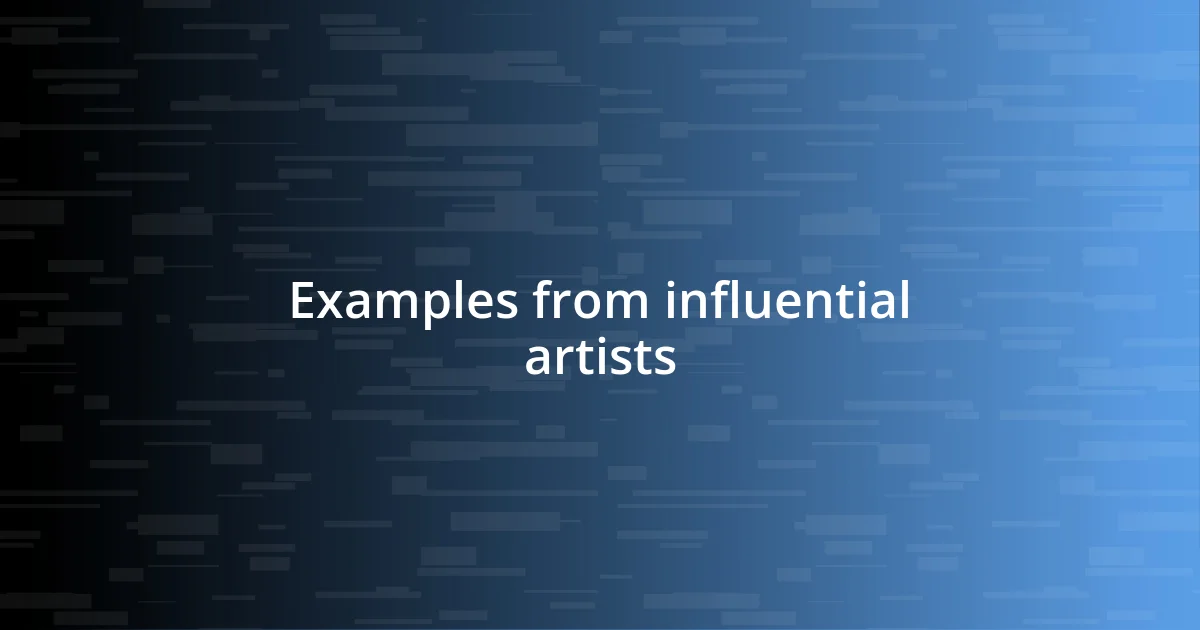
Examples from influential artists
One artist that comes to mind is David Bowie, who masterfully blended rock with elements of pop, electronic, and even jazz. His iconic album, Ziggy Stardust, isn’t just a rock album; it’s a theatrical experience that transforms the music into a narrative about identity and persona. I remember the first time I heard “Starman”—Bowie’s marriage of glam rock with a sci-fi narrative truly ignited my imagination. It’s fascinating how his exploration of genres not only pushed musical boundaries but also challenged societal norms.
Then there’s Billie Eilish, who intertwines pop with dark wave and electronic sounds, creating a haunting sonic landscape that feels deeply personal. Listening to her track “When the Party’s Over” was an eye-opening moment for me. The way she juxtaposed minimalist production with raw, emotional lyricism struck a chord. Have you ever felt that chill when a song resonates so deeply? Eilish’s unique genre blending highlights how breaking conventional molds can elicit profound emotional responses from listeners.
Another remarkable example is the band Mumford & Sons, who seamlessly merge folk-rock with elements of indie and even pop sensibilities. Their hit “I Will Wait” embodies this blend—mixing traditional acoustic instrumentation with a modern anthemic feel. I feel a rush of excitement each time the chorus hits; it’s like a celebration of both nostalgia and innovation. Isn’t it incredible how they capture the heart of two genres, creating something entirely new that resonates with a diverse audience?
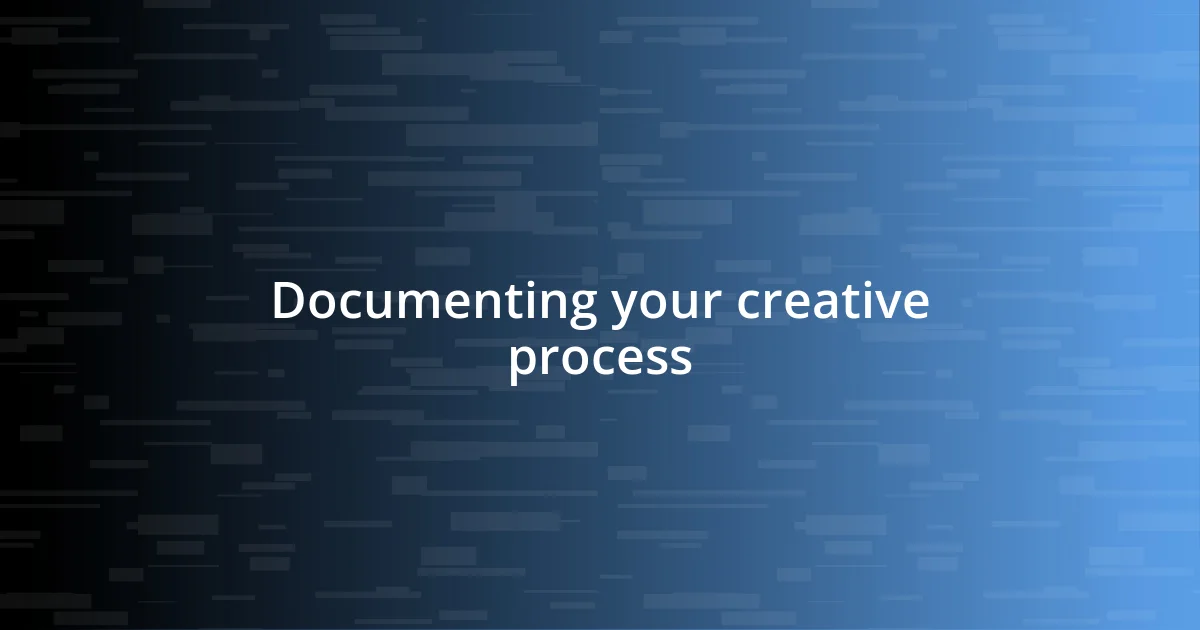
Documenting your creative process
When I reflect on my creative journey, I often wish I had documented every moment—a journal filled with thoughts, sketches, and ideas. Writing down my processes has not only helped me track my progress but also revealed the underlying patterns in my creativity. Have you ever noticed the small epiphanies that emerge while jotting down your thoughts? Those fleeting moments can often bear the seeds of your best ideas.
I’ve found that recording my experiments allows me to examine my emotional landscapes during the writing process. One time, while crafting a dark fantasy tale, I struggled with feelings of anxiety and excitement. Looking back at my notes, I discovered how those emotions fueled my creativity and shaped the characters’ journeys. Isn’t it fascinating how your emotional state can influence the narrative arc? By capturing these reflections, I’ve been able to channel those feelings more effectively into my work.
Documenting my creative process extends beyond just words; I often capture visuals that inspire me. Photos, sketches, and even color palettes provide rich context for my stories. I remember a time I began blending genres with a setting inspired by a photograph I took on a rainy day—it became the backdrop for a whimsical yet eerie tale. Each visual element evokes a specific emotional response, transforming mere concepts into tangible experiences. How do you think imagery influences your storytelling? For me, it’s an essential part of weaving depth into my narratives.
